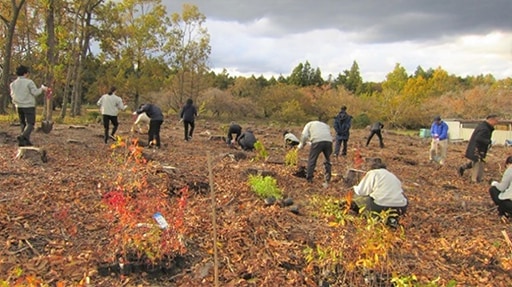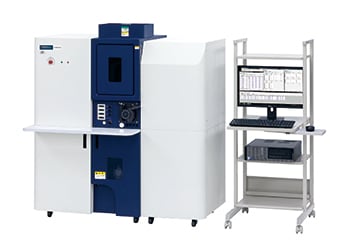Information Disclosure Based on TNFD Recommendations: Strategy
Initiative 2 for Priority Locations: Hitachi High-Tech Science Fuji Oyama Works (36-1 Takenoshita, Oyama Town, Sunto District, Shizuoka Prefecture, Japan)
Fuji Oyama Works of Hitachi High-Tech Science offers a wide variety of products for a wide range of industries including connected, mobility, environment, energy and healthcare with its technical capabilities in surface analysis, elemental and physical property analysis, and spectroscopic and separation analysis.
In its business activities, it uses water for such purposes as cleaning and cooling precision parts and equipment, and it depends on groundwater for the majority of its water use. For this reason, it is continuously working to improve the efficiency of water use and is conducting its business activities in consideration of the local nature.
Specifically, it has established the Woodlands of Hitachi High-Tech Science on its premises to conserve local native species, and it is also actively involved in local environmental conservation efforts, such as cleaning up nearby Mt. Fuji and the surrounding area.

Protection, Restoration, and Regeneration of Biodiversity : Woodlands of Hitachi High-Tech Science
The Woodlands of Hitachi High-Tech Science cover approximately 44,000 m2 *1 within the grounds of the Hitachi High-Tech Science Fuji Oyama Works. Aiming to realize harmony with nature as a member of the local community, since 2015 we have been working to convert artificial woodland into natural broadleaf woodland using local native plants grown on the site. In addition to planting sawtooth oak and konara oak saplings — which are both traditional native species — grown from acorns collected on the site, we have also been planting saplings of all sizes such as Japanese maple, Japanese snowbell, and Japanese beautyberry, with the aim of regenerating the woodland with a wider variety of trees. We are also maintaining the Japanese pampas grass area by dividing and replanting them to convert a part of the grassland into a semi-natural field of Japanese pampas grass containing a variety of native plant species. As part of our forest planning activities, employees are also participating in the removal of invasive plants and the creation of insect hotels as nest sites for insects. Rare plants have also been identified on the premises.

As a result of these efforts, we received the highest rating of AAA (Triple-A) at JHEP certification*2 by the Ecosystem Conservation Society-Japan. In addition, the site has been certified by the Ministry of the Environment as a Natural Symbiosis Site*3 which is an “area where biodiversity is protected through private initiatives.” It is also registered with the OECM*4, an international initiative. In addition, we will contribute to the realization of carbon neutrality through the protection, restoration, and regeneration of ecosystems by regularly calculating the amount of CO2 accumulated as a result of these forest maintenance activities.
Please refer to the following news release for details on JHEP certification and certification of Natural Symbiosis Sites.

*1 Of this area, 32,000 m2 is registered as a Natural Symbiosis Site.
*2
JHEP: JHEP(Japan Habitat Evaluation and Certification Program) compares the value of biodiversity in the past before the project and in the future after the project and evaluates and ranks the difference. This is the only certification system in Japan that clearly states that the company is conducting business that does not reduce or improves the quantity and quality of nature compared to the past.
News release: Woodland of Hitachi High-Tech Science Receives Highest JHEP Certification Ranking Following Renewal
*3
Natural Symbiosis Site:Areas designated by the Ministry of the Environment where biodiversity is being conserved through private-sector efforts.
It was introduced as part of the “30 by 30” target to conserve and protect at least 30% of the country‘s land and sea areas by 2030.
News release: The Woodlands of Hitachi High-Tech Science Certified by the Ministry of the Environment as a Natural Symbiosis Site
*4 OECM:OECM(Other Effective area-based Conservation Measures) is a non-protected area that contributes to biodiversity conservation.
Nature-related Opportunities in Business Activities: Examples of Expected Contributions to Water Quality Testing Initiatives for Tap Water and Rivers
As global warming progresses, water problems will become more serious worldwide, and we can expect risks such as water depletion and declining water quality.
Our sequential high resolution ICP optical emission spectrometer can measure very small amounts of components in substances with high precision using light, making it possible to test the quality of tap water and rivers, and to analyze the components of substances for which precision is required.
The use of our analytical instruments, such as high-resolution sequential ICP optical emission spectrometers, is expected to help safeguard a healthy water environment.

*Sold only in Japan
Example: Analysis of mineral water from three different sources
(Unit: ppb)
| Sample source | Vanadium | Arsenic | Cadmium |
|---|---|---|---|
| 1 | 0.86 | 0.72 | 0.00 |
| 2 | 59.6 | 0.49 | 0.00 |
| 3 | 1.93 | 0.75 | 0.19 |
